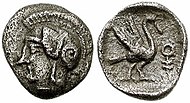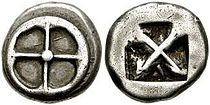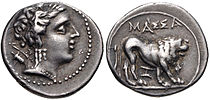Ancient drachma
Inancient Greece,thedrachma(Greek:δραχμή,romanized:drachmḗ,[drakʰmέː];pl.drachmaeordrachmas) was an ancient currency unit issued by many city-states during a period of ten centuries, from theArchaic periodthroughout theClassical period,theHellenistic periodup to theRoman period.The ancient drachma originated in the Greece around the 6th century BC.[1]The coin, usually made of silver or sometimes gold[2]had its origins in a bartering system that referred to a drachma as a handful of wooden spits or arrows.[3]The drachma was unique to each city state that minted them, and were sometimes circulated all over the Mediterranean.[4]The coinage ofAthenswas considered to be the strongest and became the most popular.[4]
Origins[edit]
The namedrachmais derived from the verbδράσσομαι(drássomai,"(I) grasp" ).[n 2]It is believed that the same word with the meaning of "handful" or "handle" is found inLinear Btablets of theMyceneanPylos.[7][n 3]Initially a drachma was a fistful (a "grasp" ) of sixoboloíorobeloí(metal sticks, literally "spits") originally used for roasting lamb.[3]With anthropological evidence it is believed that the oboloi were used as a form of early currency, beginning around 1100 BC and being a form of "bullion":bronze, copper, or iron ingots denominated by weight in a developed barter system.[3]The earliest of these obeloi were found in Palaepahos, Cyprus in a Geometric grave. Anthropological evidence suggests that obeloi were used in burials of warrior elite or in the graves of people with high social status.[10]Ahoardof over 150 rod-shaped obeloi was uncovered atHeraion of ArgosinPeloponnese.Six of them are displayed at theNumismatic Museum of Athens.Despite earlier evidence of poorly preserved specimen, the obeloi discovered at Argos were the first found completely intact.[10]
The drachma was the standard unit of silver coinage at most ancient Greek mints, and the nameobolwas used to describe a coin that was one-sixth of a drachma.[2]The notion thatdrachmaderived from the word for fistful was recorded byHerakleides of Pontos(387–312 BC) who was informed by the priests of Heraion thatPheidon,king of Argos, dedicated rod-shaped obeloi to Heraion. Similar information about Pheidon's obeloi was also recorded at theParian Chronicle.
Characteristics[edit]
Ancient Greek coinsnormally had distinctive names in daily use. The Atheniantetradrachmwas calledowl,[11]theAeginetic staterwas calledchelone,the Corinthianstaterwas calledhippos(horse) and so on. Each city would mint its own and have them stamped with recognizablesymbols of the city,known asbadgein numismatics, along with suitable inscriptions, and they would often be referred to either by the name of the city or of the image depicted.[12]The exact exchange value of each was determined by the quantity and quality of the metal, which reflected on the reputation of each mint.[2]Coins were most often made of silver, and very rarely gold.[2]
Geographic spread[edit]
Among the Greek cities that used the drachma were:Abdera,Abydos,Alexandria,Aetna,Antioch,Athens,Chios,Cyzicus,Corinth,Ephesus,Eretria,Gela,Catana,Kos,Maronia,Naxos,Pella,Pergamum,Rhegion,Salamis,Smyrni,Sparta,Syracuse,Tarsus,Thasos,Tenedos,Troyand more. Most coins only circulated within the region they were created in, and there was no universal standard. However, more than half the known Greek city-states do not have evidence of minting coins.[13]
Fractions and multiples of the drachma were minted by many states, most notably inPtolemaic Egypt,which minted large coins in gold, silver and bronze.
Notable Ptolemaic coins included the goldpentadrachmandoctadrachm,and silvertetradrachm,decadrachmandpentakaidecadrachm.[14]This was especially noteworthy as it would not be until the introduction of theGuldengroschenin 1486 that coins of substantial size (particularly in silver) would be minted in significant quantities.
After Alexander's conquests, the namedrachmawas used in many of theHellenistickingdoms in theMiddle East,including thePtolemaickingdom inAlexandriaand theParthian Empirebased in what is modern-dayIran.TheArabicunit of currency known asdirham(Arabic:درهم), known from pre-Islamictimes and afterwards, inherited its name from the drachma or didrachm (δίδραχμον,2 drachmae); the dirham is still the name of the official currencies ofMoroccoand theUnited Arab Emirates.TheArmenian dram(Armenian:Դրամ) also derives its name from the drachma.
Athenian coinage[edit]
The 5th century BC Athenian tetradrachm ( "four drachmae" ) coin featured the helmeted profile bust ofAthenaon the obverse (front) and an owl on the reverse (back). In daily use they were calledγλαῦκεςglaukes(owls),[15]hencethe proverbΓλαῦκ' Ἀθήναζε,'an owl to Athens', referring to something that was in plentiful supply, like 'coals to Newcastle'. The reverse is featured on the national side of the modernGreek 1 euro coin.
The tetradrachm ( "four drachmae" )coinwas perhaps the most widely used coin in the Greek world prior to the time ofAlexander the Great(along with theCorinthianstater).[2]Athenian coinage was especially attractive due to the purity of the silver used to create each coin.[4]At the time, to gain legitimacy over a large geographic spread, city states relied on the intrinsic value of their coins and the promise that "its minting authority would redeem it". Athens demonstrated both. Athenian coinage was one of the few coins accepted internationally.[2]The popularity of Athen's coinage can be contributed to numerous laws restricting local traders to exclusive use of Athenian coinage abroad.[16]The only specific coinage mentioned in Herodotus is the drachma of Athens.[17]
Evidence for the usage of silver coinage can be found in multiple sections ofHerodotus.In 6.21 the tensions between the Athenians and Miletus result in a discussion of equal return and exchange involving coins.[18]In Herodotus 8.93 a prize of ten thousand drachmae is offered in exchange for a prisoner.[19]
The valuable silver used in Athenian coins was gathered from Athens's Laurium Mines in Attica, which were subject to large-scale use and exploitation beginning in the 6th century BCE.[20]Mining was strictly overseen by the Athenian state.[20]In Herodotus 7.144 there is specific discussion of the wealth that Athens gathered from these mines. He states, "The revenues from the mines at Laurium has brought great wealth into the Athenian's treasury."[21]
Usages in Ancient Greece[edit]
The primary function of the first coinage is highly debated by scholars. Historian Sitta von Reden states that, "The great number of possible explanations, none of which are {sic} wholly satisfactory, has made scholars abandon the question of the primary function of the first coinages."[10]But there is some anthropological evidence for different uses of coins over time in Ancient Greece.
Most historians find consensus in the use of coinage to facilitate trade.[10]Such use of coinage is attested to in such primary sources as Herodotus 1.94.; he says that theLydianswere the first to mint coins and use them "for retail."[22]
Since trade was state controlled, trade and political factors are highly interlocked. Ancient coinage also had religious use.Obeloiwere often used in dedications at shrines and temples. Anthropological evidence of this can be found at the Apollo sanctuary at Delphi, the Apollo temple at Halieis, and the sanctuary of Hera and Zeus at Olympia.[23]Though debated, historians believe that the use of these items in a religious context is significant. Additionally, "penalties, tithes and other dues were inflicted on both priests and worshippers" and were extracted through bullion weight or coinage.[10]
Many historians believe that coins were used as a tool for empire building, as a Greek City state could enforce its power and establish political order through managing its coins.[10]
There is also historic speculation that coins were manufactured and used as a form of civic pride. Thomas R. Martin says that the use of coinage in ancient Greece, could be loosely compared to the use of flags in the modern world.[13]Martin says that coins thus functioned "as symbols of sovereign identity"[13]
Coinage was used for rewards at athletic games, which were an integral part of Greek life. Victors of games were often given prizes with monetary value, such as bronze and silver containers, tripods, and coins.[10]
In daily life, coins were used for such social transactions as marriage and transfer of land, although far less is known about these exchanges.[10]Anthropological evidence shows that marriages were events in which coins would be exchanged from one party to another.[10]Other items received in dowry exchanges were appraised by their monetary value, measured in coins.Dowrieswere usually paid for in cash. For a wealthy Athenian family this could include between "500 dr and 2 talents."[10]
Value[edit]
Weight value[edit]
Drachmae were minted on different weight standards at different Greek mints. The standard that came to be most commonly used was the Athenian orAttic standard,which weighed a little over 4.3 grams.[2]
Modern value and comparison[edit]
In the heyday of ancient Greece (the fifth and fourth centuries) the daily wage for a skilled worker or ahoplite[24]was one drachma, and for aheliast(juror) half a drachma since 425 BC.[25]Before the Peloponnesian War (beginning in 431), which caused significant inflation, a laborer might earn one-third of a drachma per day.[2]
Modern commentators derived fromXenophon[26]that half a drachma per day (360 days per year) would provide "a comfortable subsistence" for "the poor citizens" (for the head of a household in 355 BC). Earlier in 422 BC, we also see in Aristophanes (Wasps,line 300–302) that the daily half-drachma of a juror is just enough for the daily subsistence of a family of three.[27]
It is difficult to estimate comparative exchange rates with modern currencies because the range of products produced by economies of centuries gone by were different from today.Purchasing power parity (PPP)calculations are very difficult.
An 1885 paper by William Goodwin estimated that, ignoring purchasing power, the weight of silver that had been in a Solonic talent was at that time worth approximately 877 United States dollars, making a drachma worth $0.14 in 1885 ($4.96 in 2023). However, he said that "these comparisons of the Attic talent with a fluctuating commodity like silver at the present day are, of course, highly unsatisfactory"; using an alternate method accounting for average bullion prices over some decades, he arrived at $1,000 for a talent, which means that based solely on bullion value, a drachma would have been worth $0.16 in 1885 ($5.65 in 2023).[28]
But bullion equivalent calculations do not provide a complete picture of a currency's value.[29]Using a labor-equivalent calculation, a silver drachma (ordenarius), which constituted a day's wage for a manual laborer, would be worth approximately the same in modern currency.[29]The United Statesfederal minimum wage's maximum purchasing power was in 1968, when it was $1.60 ($14.00 in 2023), meaning an 8-hour shift paid $12.80 ($112.00 in 2023)[30][29]Meanwhile, average yearly wages in the United States in 2022 were $77,463 ($80,652 in 2023), meaning a day's wages would be $322.76 ($336.00 in 2023).[31]
Taking into account economic statistics around the world, a broader range of estimates is possible. According to theUNECE(United Nations Economic Commission for Europe), gross average monthly wages in 2020 ranged from $7,712.7 USD (Switzerland) to $265.10 USD (Uzbekistan);[32]this yields a range between $385.63 ($454.00 in 2023) and $13.26 ($16.00 in 2023).
Food and clothing were expensive from a modern perspective. A gallon of olive oil cost three drachmae, while cloaks could range anywhere between five and twenty drachmae.[2]
For the Roman successors of the drachma, seeRoman provincial coins.
Denominations of ancient Greek drachma[edit]
The weight of the silver drachma was approximately 4.3 grams or 0.15 ounces,[33]although weights varied significantly from one city-state to another. It was divided into six obols of 0.72 grams, which were subdivided into four tetartemoria of 0.18 grams, one of the smallest coins ever struck, approximately 5–7 mm in diameter.[34]
| Denominations of Greek silver | ||||
|---|---|---|---|---|
| Image | Denomination | Value | Weight | Greek |
 |
Dekadrachm | 10 drachmae | 43 grams | Δεκάδραχμον |
 |
Tetradrachm | 4 drachmae | 17.2 grams | Τετράδραχμον |
 |
Didrachm | 2 drachmae | 8.6 grams | Δίδραχμον |
 |
Drachma | 6 obols | 4.3 grams | Δραχμή |
 |
Tetrobol | 4 obols | 2.85 grams | Τετρώβολον |
 |
Triobol (hemidrachm) |
3 obols (1⁄2drachma) |
2.15 grams | Τριώβολον[n 4] (ἡμίδραχμον) |
 |
Diobol | 2 obols | 1.43 grams | Διώβολον |
 |
Obol | 4 tetartemoria (1⁄6drachma) |
0.72 grams | Ὀβολός (ὀβελός) |
 |
Tritartemorion | 3 tetartemoria | 0.54 grams | Τριταρτημόριον (τριτημόριον) |
 |
Hemiobol | 2 tetartemoria (1⁄2obol) |
0.36 grams | Ἡμιωβέλιον (ἡμιωβόλιον)[n 5] |
 |
Trihemitetartemorion | 1+1⁄2tetartemorion | 0.27 grams | Τριημιτεταρτημόριον |
 |
Tetartemorion | 1⁄4obol | 0.18 grams | Τεταρτημόριον (ταρτημόριον, ταρτήμορον) |
 |
Hemitetartemorion | 1⁄2tetartemorion | 0.09 grams | Ἡμιτεταρτημόριον |
Historic currency divisions[edit]
- 12chalkoi= 1obolus
- 6oboloi= 1drachma
- 70drachmae= 1mina(ormna), later 100drachmae= 1mina[35]
- 60minae= 1Athenian Talent(Athenian standard)[36]
Minae and talents were never actually minted: they represented weight measures used for commodities (e.g. grain) as well as metals like silver or gold.
In culture[edit]
- JesusinstructsPeterto pay a didrachmaJerusalem templetax in their own behalf,Mt 17:24–.
- William Shakespeare mentions the drachma in his playJulius Caesar,in Mark Antony's famous "Friends, Romans, Countrymen[37]"speech.
The coin appears in 21st century video games and fantasy novels:
- Drachma is the currency used in the video gameSpy Fox in "Dry Cereal"(2008), set in the fictional Greek island of Acidophilus.
- The golden drachma is the main unit of currency inRick Riordan'sPercy Jackson & the Olympiansfantasy adventure novel series. It also is featured in its spinoffThe Heroes of Olympus,which includes the Romandenarius.
- The drachma is used in the video gameAssassin's Creed Origins,set inPtolemaic Egypt;players may purchase weapons, outfits and mounts with it. It is also used in the subsequent gameAssassin's Creed Odyssey,set inAncient Greece.
See also[edit]
Notes[edit]
- ^δράσσομαι,drassomai,"grasp";cf.:δράξ,drax,anddrachmaitself, i.e. "grasp with the hand".[5][6]
- ^"As much as one can hold in the hand".[5][6]
- ^The word, whose meaning and translation is still uncertain, is𐀈𐀏𐀔,do-ka-maor𐀈𐀏𐀔𐀂,do-ka-ma-i,found on thePYAn 1282 and PY Wr 1480 tablets.[8][9]
- ^Τριόβολον spelling variant is also attested.
- ^Ἡμιοβόλιον spelling variant is also attested.
References[edit]
- ^"Drachma | Definition, History, & Facts | Britannica".britannica.Archivedfrom the original on 2023-04-13.Retrieved2023-06-04.
- ^abcdefghiStrassler, Robert B. (1996).The Landmark Thucydides.New York, NY: Free Press. p. 620.
- ^abcCourbin, Paul (1956)."Discoveries at Ancient Argos".Archaeology.9(3): 166–174.ISSN0003-8113.JSTOR41666048.Archivedfrom the original on 2023-05-19.Retrieved2023-06-05.
- ^abcTrade in Ancient Greece,archivedfrom the original on 2023-05-19,retrieved2023-05-19
- ^abδραχμή.Liddell, Henry George;Scott, Robert;A Greek–English Lexiconat thePerseus Project.
- ^abδράσσομαιinLiddellandScott.
- ^Shelmerdine, Cynthia W.;Bennet, John (1 January 1995)."Two Linear B documents from Bronze Age Pylos".Kadmos.34(2).doi:10.1515/kadm.1995.34.2.123.S2CID161844846.Archivedfrom the original on 27 May 2023.Retrieved26 May2023.
- ^"PY 1282 An (Ciii)".Archivedfrom the original on 2014-03-16.Retrieved2023-05-26."PY 1480 Wr (unknown)",DĀMOS: Database of Mycenaean at Oslo,University of Oslo,archivedfrom the original on 2015-04-02,retrieved2023-05-26.
- ^Raymoure, K.A."do-ka-ma-i".Minoan Linear A & Mycenaean Linear B.Deaditerranean. Archived fromthe originalon 2017-02-25.Retrieved2023-05-26.
- ^abcdefghijvon Reden, Sitta (1997)."Money, Law and Exchange: Coinage in the Greek Polis".The Journal of Hellenic Studies.117:154–176.doi:10.2307/632554.ISSN0075-4269.JSTOR632554.S2CID159753653.Archivedfrom the original on 2023-05-19.Retrieved2023-06-05.
- ^Philochorus:Scholion to Aristophanes, Birds 1106
- ^Kroll, John H.; Walker, Alan S. (1993)."The Greek Coins".The Athenian Agora.26:iii–376.doi:10.2307/3602004.ISSN1558-8610.JSTOR3602004.Archivedfrom the original on 2023-06-04.Retrieved2023-06-05.
- ^abcMartin, Thomas R. (1996)."Why Did the Greek" Polis "Originally Need Coins?".Historia: Zeitschrift für Alte Geschichte.45(3): 257–283.ISSN0018-2311.JSTOR4436427.Archivedfrom the original on 2023-05-19.Retrieved2023-06-05.
- ^Mørkholm, Otto (1975)."Ptolemaic Coins and Chronology: The Dated Silver Coinage of Alexandria".Museum Notes (American Numismatic Society).20:7–24.ISSN0145-1413.JSTOR43574137.Archivedfrom the original on 2023-06-04.Retrieved2023-06-05.
- ^γλαύξinLiddellandScott.
- ^Stroud, Ronald S. (1974)."An Athenian Law on Silver Coinage".Hesperia: The Journal of the American School of Classical Studies at Athens.43(2): 157–188.doi:10.2307/147454.ISSN0018-098X.JSTOR147454.Archivedfrom the original on 2023-05-19.Retrieved2023-06-05.
- ^"The Landmark Herodotus: the histories".Choice Reviews Online.45(9): 45–5139–45-5139. 2008-05-01.doi:10.5860/choice.45-5139.ISSN0009-4978.
- ^"Herodotus, The Histories, Book 6, chapter 21".perseus.tufts.edu.Archivedfrom the original on 2023-07-22.Retrieved2023-06-04.
- ^"Herodotus, The Histories, Book 8, chapter 93".perseus.tufts.edu.Archivedfrom the original on 2023-06-04.Retrieved2023-06-04.
- ^ab"Historical Reading List: The Ancient Silver Mines at Laurium, Greece".gia.eduhttps.Archivedfrom the original on 2023-06-09.Retrieved2023-05-19.
- ^"Herodotus, The Histories, Book 7, chapter 144".perseus.tufts.edu.Archivedfrom the original on 2023-06-04.Retrieved2023-06-04.
- ^"Herodotus, The Histories, Book 1, chapter 94".perseus.tufts.edu.Archivedfrom the original on 2023-06-04.Retrieved2023-06-04.
- ^Gardner, P. (1913)."Coinage of the Athenian Empire".The Journal of Hellenic Studies.33:147–188.doi:10.2307/624107.ISSN0075-4269.JSTOR624107.S2CID163998324.Archivedfrom the original on 2023-05-19.Retrieved2023-06-05.
- ^Thucydides,History of the Peloponnesian War3.17.4Archived2020-09-14 at theWayback Machine.
- ^It was originally set at 1/6 drachma by Pericles, untilCleonraised it in 425 BC; see alsoAristophanes,Knights(line 255) andWasps(line 609, 684, 690, 788–790, 1121).
- ^Cf. footnote 18 of H. G. Dakyns's translation ofWays and Means: A Pamphlet on RevenuesaliasOn RevenuesArchived2023-03-26 at theWayback Machine(The Works of Xenophon,Macmillan, 1897). This footnote is quoting George Grote (Plato, and the Other Companions of Sokrates,vol. 3, J. Murray, 1865, p.597).
- ^Aristophanes (1988), MacDowell, Douglas M. (ed.),"Wasps",Aristophanes: Wasps,Oxford University Press,doi:10.1093/oseo/instance.00233597,ISBN978-0-19-814465-6,archivedfrom the original on 2024-01-02,retrieved2023-06-04
- ^Goodwin, William W. (1885)."The Value of the Attic Talent in Modern Money".Transactions of the American Philological Association.16:116–119.doi:10.2307/2935785.hdl:2027/hvd.32044080858715.JSTOR2935785.Archivedfrom the original on 2023-07-14.Retrieved2023-07-14.
- ^abc"What Were They Worth? The Purchasing Power of Ancient Coins".4 September 2018.Archivedfrom the original on 8 March 2023.Retrieved15 July2023.
- ^Wenger, Jeffrey B. (September 2016)."Working for $7.25 an Hour: Exploring the Minimum Wage Debate".Rand.Archivedfrom the original on 2020-08-04.Retrieved2017-12-14.
By 1968, the minimum wage had reached its peak purchasing power of $1.60 per hour ($11.08 in 2016 dollars).
- ^"Average annual wages: Table N1. Real average annual wages".Archivedfrom the original on 2023-06-27.Retrieved2023-07-14.
- ^"Gross Average Monthly Wages by Indicator, Country and Year".Archivedfrom the original on 2024-01-02.Retrieved2023-07-14.
- ^British Museum Catalogue 11 – Attica Megaris Aegina
- ^Photo gallery ofTetartemoriaArchived2013-11-11 at theWayback Machineand other small Greek coins
- ^Aristotle,Athenian Constitution, 10.2
- ^Drachma,The Catholic Encyclopedia, Volume V. Published 1909. New York: Robert Appleton Company. Nihil Obstat, 1 May 1909. Remy Lafort, Censor. Imprimatur. John M. Farley, Archbishop of New York
- ^"JULIUS CAESAR, Act 3, Scene 2".Archivedfrom the original on 2020-11-05.Retrieved2023-05-26.






